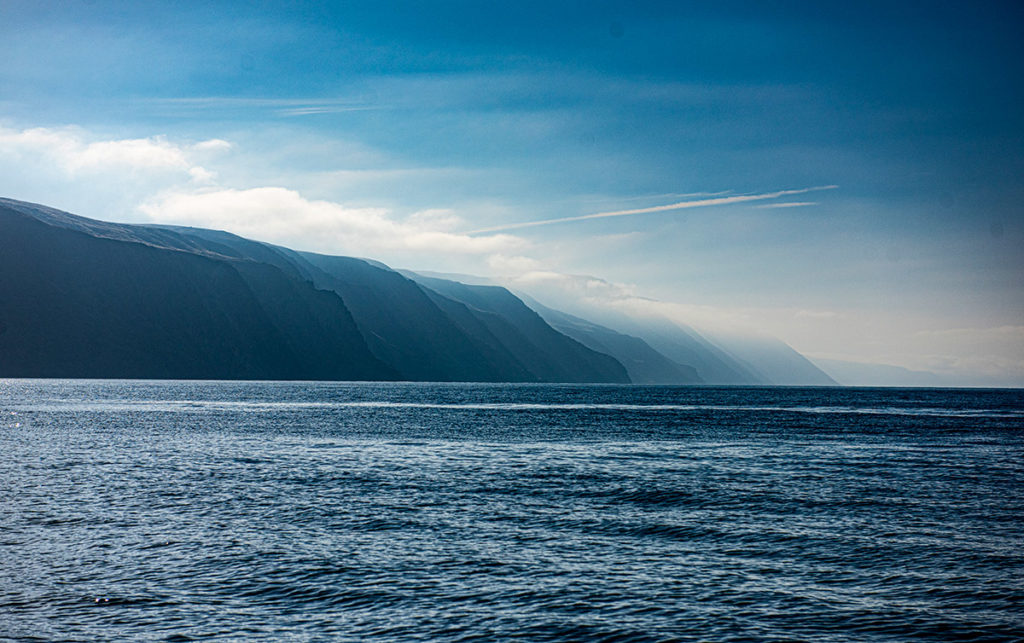August 2 | Michl Binderbauer
A Breath of Fresh Air

San Clemente Island, California. Photo: Nick Gates
In the decades that I’ve lived in Southern California, I’ve been able to see San Clemente Island, located about 60 miles off the coast, on just a handful of days. Otherwise, even if you know what you’re looking for, you may at best catch a glimpse of a blurry gray blob in the Pacific Ocean.
Less than 10 days into California’s shelter-in-place order for the Coronavirus, I looked out the window and was amazed to see the island in clear enough detail to make out its sea cliffs and shoreline. This wasn’t because I was home and able to gaze at it more often or more intently than usual. Actual change was in the air.
Prior to the global outbreak, human impact on the environment was largely studied in models and projections, making the cause and effect seem abstract to some. Now, we are all partaking in an unprecedented living laboratory experiment, where the drastic reduction of planes, cars, and factory activity has led to results that are starkly visible in our everyday lives. The air has been measurably cleaner, and wildlife has reclaimed some of its habitat.
Yes, emissions levels have rebounded, coinciding with increased activity since the earliest days of the pandemic, but we now have some proof of the Earth’s resilience – in less time than it’s taken some people to receive their COVID-19 test results.
Unfortunately, the environmental gains of this living laboratory experiment also coincide with personal and economic hardship. With the convergence of the virus, climate change, the social justice movement, and many other factors, the drumbeat gets louder every day: We can’t go back to the way things were. We are in dire need of a new paradigm that benefits everyone on a human, environmental, and economic level all at once. That’s where I hope TAE comes in.
I feel fortunate that I was taught to consider this connection early in my career. I moved from Austria in the late 1980s to attend the University of California, Irvine. There, I met my mentor, the late Dr. Norman Rostoker, a professor and early fusion pioneer. The potential of fusion as the world’s most clean, safe, sustainable source of energy was established thanks to people like him and many others.
Norman was a visionary and recognized early on that in order for fusion to realize this potential, scientists must both achieve the significant laboratory milestone of net energy – getting more out of the fusion reaction than is needed to keep it going – and, maybe even more critically, develop a viable solution for wide scale grid integration and distribution. We developed a prototype concept accordingly.
By 1998, the company now known as TAE Technologies was launched to develop a comprehensive fusion solution “with the end in mind.” “The end” being mass reliance on fusion power as a safe, cost- competitive energy source for everyone around the world, distributed via scalable, commercial fusion power plants, and achieving this outcome with the most upside for the planet. To meet this two- pronged goal, TAE took fuel choice, device size, environmental impact, power plant maintenance, and many other factors into consideration. With the “end in mind” mantra, and drawing upon any scientific discipline necessary in addition to traditional plasma physics, we reverse engineered our path forward – no matter what had to be researched … or invented … along the way.
Just like technologies designed by NASA for space exploration were then used for more everyday items like Nikes and the Dustbuster, in designing solutions for disparate, future problems, TAE recognized that the advances we made for our unique fusion configuration can have transformational benefit in other sectors as well. Our proprietary power management system and particle accelerator beams are now being leveraged for commercial applications in electric vehicles, a promising new cancer treatment, and more.
In the past, some people may not have embraced sustainable technologies perhaps because of a perceived compromise in convenience, quality, and/or economics. Today, we are seeing a proliferation of investments and employment opportunities in this thriving sector as tangible progress, social responsibility, and economic value increasingly align. This means that what’s good for humanity and the planet is good for the economy. In a time of deep uncertainty, this is a very encouraging sign.
Due to Coronavirus, we recently saw how the unexpected reduction in combustible power technologies could make a dent in fossil fuel emissions in such a short time. Imagine a world where we purposefully replace known pollutants with a mix of clean energy alternatives that can help rebalance the atmosphere, and are robust enough to support the nearly doubling of global power demand by 2050. This world will provide for a more equitable society and economic prosperity. It is this world that the TAE team and I have committed ourselves to for over 20 years, and while it may sometimes be shrouded in a familiar fog, we know, like San Clemente Island, this world is just within reach.